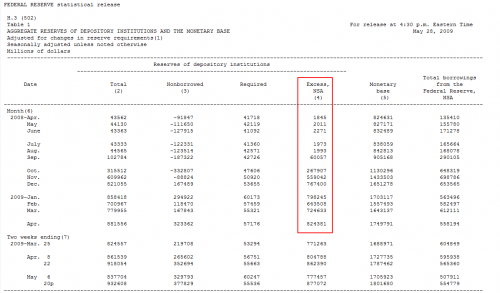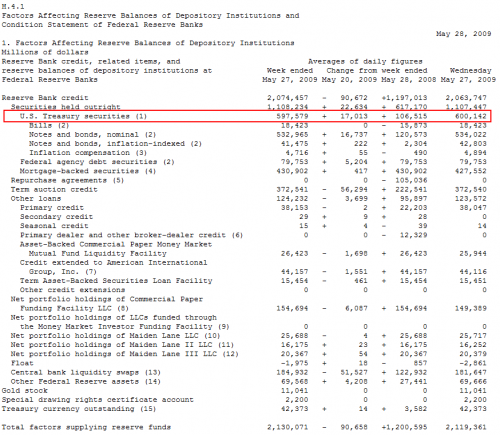Central banks will face a Scylla and Charybdis flation challenge for years
Nearly a month ago, back on May 5th, I highlighted some testimony by Federal Reserve Chairman Ben Bernanke before congress in a post labelled, “Bernanke expects recovery later this year". In his testimony, Bernanke used the phrase ‘Scylla and Charybdis’ to describe the Federal Reserve’s policy challenge regarding deflationary and inflationary forces. I would like to highlight this characterization because I believe it goes to the core of the debate as to how the global economy and asset markets will fare over the next 5-10 years. In my view (and apparently in Bernanke’s), both inflationary forces and deflationary forces will be at work for some time to come. This will present policy makers with a problem as the reflation trade comes good, and the resulting policy responses will have serious implications on the medium term outlook for the economy and asset markets.
Deflationary forces
The problem is this: we have just witnessed one of the most serious asset bubbles in history. In fact, I would call the great housing bubble an ‘echo bubble’ that was merely a continuation of the bubble forces that created the technology bubble of the late 1990s. So, the world saw asset price inflation of the most severe kind for over a decade – from the mid 1990s when Alan Greenspan first voiced concern about ‘irrational exuberance"’ to 2007 when the housing bubble imploded. What results from the implosion of such a significant bubble is deflation.
Actually, more crisply put, what results is ‘the D-process,’ an outcome highlighted by Ray Dalio of Bridgewater Associates (see my post "A conversation with Bridgewater Associates’ Ray Dalio" for more detail). This process involves the three D’s of deleveraging, deflation and depression (outlined in my post “We are in depression").
Richard Koo goes further in his book “The Holy Grail of Macro Economics.” Here, he argues that the unwind of great bubbles suffers from what he labels a ‘balance sheet recession.’ In essence, companies go from maximizing profits, as they had done in normal times, to a post-bubble concern of reducing debt. Regardless of how much priming of the pump monetary authorities do, the psychology of debt reduction will limit the effectiveness of monetary policy as a policy tool.
In my view, the catalyst for this change of psychology is the ‘debt revulsion’ that ushers in the panic phase of an asset bubble collapse. (Charles Kindleberger highlights the various stages of a bubble and its implosion in his seminal book “Manias, Panics and Crashes”). In this particular bubble, debt revulsion began post-Lehman Brothers. What we have seen, therefore, is a reduction in leverage and debt as the most leveraged players have gone to the wall. But, more than that, the household sector has got religion about debt reduction as the savings rate has increased dramatically since Lehman. In fact, I would argue that companies learned their lesson about debt from the aftermath of the tech bubble. It is the household sector in the U.S. (and the U.K.) which is heavily indebted. Therefore, if the psychology of a balance sheet recession does take form, it will be the household sector leading the charge.
In sum, the psychology after a major bubble is very different than the psychology before its collapse. The post-bubble emphasis becomes debt reduction and savings, making monetary policy ineffective, not because financial institutions are unwilling lenders but because companies and individuals are unwilling borrowers. These are forces to be reckoned with for some to come.
Inflationary forces
Meanwhile, inflation is going to be a problem too. Why? Two principle reasons come to mind: commodity prices and money supply. Now, just yesterday in my most recent post “Kasriel: ‘greater risk for the global economy…is inflation’,” I highlighted Paul Kasriel’s view that there are several inflationary forces, both secular and cyclical which will impinge upon the economy. I want to bear down on just the two forces of commodity prices and money supply.
First, let’s look at money supply. The Federal Reserve and other central banks have been pumping a lot of money into the financial system in an attempt to add reserves to the system and to take on the intermediation role the wider banking system normally serves. Nevertheless, this money is not being lent out and excess reserves are piling up at the Federal Reserve. Last April, there were only $1.8 billion in excess reserves i.e. reserves against which loans were not being made. According to figures just released by the Fed on May 28th, this April that figure has soared to $824.4 billion, a surge of 447 times in one year. If you want to know what is wrong with the American economy, you should start here.
But, what happens when the economy returns to an environment in which those excess reserves start to be lent out? Inflation. And this is an inflation that will not be so easy to control because the Federal Reserve has embarked on a policy of ‘qualitative easing’ by buying up non-treasury assets, transforming its balance sheet from one dominated by treasury assets to one in which Treasury assets are in the minority. So, as the Fed has intervened and bloated its balance sheet, an increasing amount of the assets it has with which to withdraw the excess liquidity in the system is hard to sell.
So, you have a huge amount of excess reserves, hard to sell assets on the Fed’s balance sheet. Add in the fact that the Federal Reserve is going to be loathe to choke off an incipient recovery and you have the makings of inflation when recovery takes hold.
Moreover, there is a rise in commodity prices which is adding inflation to the pipeline. Much of the recent decrease in headline inflation numbers is due to the collapse in commodity prices. But, Copper is near a seven-month high. Oil is near a seven-month high. And all of the agricultural and industrial commodities are taking off again. As China ramps up its economic stimulus, the recent increases in the ISM manufacturing data in the U.S. and elsewhere point to an increasing demand for industrial commodities, and this is inflationary.
In sum, any pickup in the economy is going to be met by a host of inflationary forces. This is one reason that bond yields have been increasing and the spread between the two-year and 10-year U.S. government bond is near a record.
Scylla and Charybdis
So, how do I see this push and pull of deflationary and inflationary forces playing out? There are two outcomes I am looking for.
Outcome Number One
- No policy traction. This is a sluggish muddle-through Japanese scenario where the Richard Koo thesis of the balance sheet recession comes into play. You would see an output gap and below-trend growth for an extended period. Most pundits would say it is the lack of lending that is creating the problem. However, what if it is the lack of borrowing which is at fault? Then, we are going to see no traction from monetary policy.
Outcome Number Two
- Start-Stop economy. I believe Bernanke would prefer this outcome. This is one in which the Federal Reserve allows the economy to recover by keeping interest rates low. The result is a rise in inflation. We could see inflation rising to 3 percent inflation and then to 5 to 7 and 10 percent. An example would be animal spirits coming back in 2010. And leading to 3 percent inflation followed by 7 percent including $100 oil and then interest rate hikes and another recession at which point the deleveraging begins again in earnest. Followed by more easing and on it goes. But, of course, the problem with outcome two is it is unstable and that it invites an aggressive policy response which risks situation one as an ultimate outcome.
Neither of these scenarios is one in which asset markets are likely to benefit, one reason I see the latest uptick in share prices as nothing more than a bear market rally.
Update 30 May 2010: Because of the enormous output gap, scenario number one is the one which will likely be operative for sometime to come. Inflation is not on the horizon. Rather, the potential for a debt deflationary outcome is greater than ever.
Update 6 Apr 2011: Now that a technical recovery is further advanced, we can start to think about scenario number two again, which demonstrates the Scylla ad Charybdis nature of the environment. I would add that the deflationary forces are mostly secular in nature and related to high debt and leverage, while, despite questions about ‘peak resources’, the inflationary forces will seem more cyclical because they create demand destruction.
Sources
H.3 Aggregate Reserves of Depository Institutions and the Monetary Base, current release – U.S. Federal Reserve website
H.4.1 Factors Affecting Reserve Balances, current release – U.S. Federal Reserve website
Copper Falls From 7-Month High on Speculation Gains Too Rapid – Bloomberg.com
Soybeans Advances to 8-Month High, Corn Gains to 7-Month Peak – Bloomberg.com
Oil Falls From Seven-Month High on Signs OPEC Output Climbing – Bloomberg.com


Ed – your conclusion to outcome no. 2 is the key, where you say that Outcome no 1 is the resultant “risk”. Maybe “likelihood” would be nearer the mark, as all those who have 1st degree burns from the recent and perhaps on-going bond market price implosion are not going to allow themselves to be so severely burnt second time around, whilst any new buyers will have learnt the lesson of not chasing rates to absurdly low levels in the future. Therefore the next time the Fed tries to play the game all over again, longer rates will not fall anywhere near as much as before, so any turn-around will be much less likely to happen. Based on your comments, stagflation does now seem to me to be the most realistic prospect.
Wow, what a thought provoking article…
Any recovery that has legs must be one that comes after substantial deleveraging/debt reduction has occurred.
Another way (not preferred) is like your number 2 choice, with the FED using inflation as a tool to reduce debt, without letting it get out of hand. Another scenario might be to devalue the dollar.
EH, does the new FED tool of paying interest on Reserves really give them much more control?
TIA
Ed,
I also want to know if the new Fed tool gives them much more control.
Barry
I think choice two seems unlikely because it would assume the Fed can always make the choice and switch between the two.
For inflation to actually take hold and benefit households repairing their balance sheets, it needs to involve wage inflation. If all the liquidity merely merely drives commodities and bank profits higher, it will just make for further wage deflation. That’s what I think is happening now. We have inflation (gas just passed $2.50/gal), but it’s just going to make the situation worse.
How can the Fed create wage inflation when there is such overcapacity world-wide?
I just wrote another post which carries this theme further. The essence of the next post is that a statistical number might serve as a good arbiter as to where this is headed. I have chosen the Consumption Income Gap (CIG) as a proxy for excess consumption. The bottom line is this: if we get more of the same in terms of excess consumption, it will show up in the CIG. If we get a balance sheet recession, the CIG will show this as well.
Right now, we are seeing income growth outstripping consumption growth. If we see this switch and stay switched for a few months, then you know reflation has taken hold.
Edward,
In the worldview you describe, do resource-based stocks like oils plummet with the US market? Since Asia and Latin America are doing better, and consuming more resources, wouldn’t that moderate drops in oil stocks?
Barry